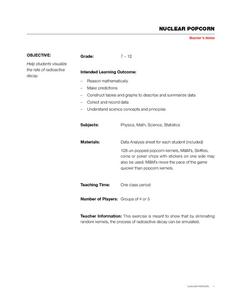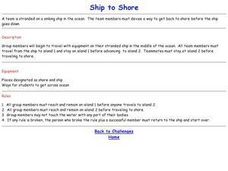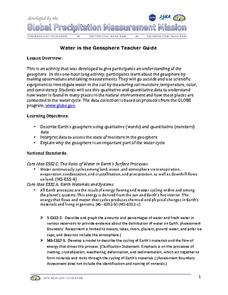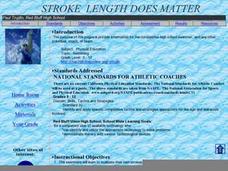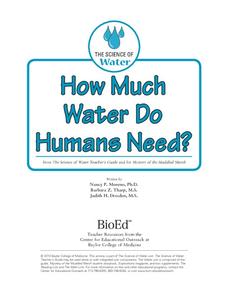Curated OER
The Ups and Downs of Technology
Students create a visual timeline of skyscrapers built in the past 20 years. In this physical science lesson, students research important facts about the building. They discuss the challenges architects face when building skyscrapers.
Curated OER
P.E. Lesson: Black Bear
Students run and try to tag a classmate as "Black Bear, Black Bear" is yelled by another student. For this P.E. lesson, students try to get to the opposite side of a playing area without being tagged or being tricked by the person who is...
National Museum of Nuclear Science & History
Nuclear Popcorn
Make your lesson on radioactive decay pop with this lab exercise. Using popcorn kernels spread over a tabletop, participants pick up all of those that point toward the back of the room, that is, those that represent decayed atoms. As the...
Curated OER
Quick Warm Ups
Here is a basic PE lesson that outlines ten different warm up games that you can utilize with your class to get them stretched out and ready for the primary activity. Some of these warm-ups could actually be used as a primary PE game for...
Curated OER
Mountain Biking - The Art of Falling
Sooner or later we all fall down. Mountain biking has its hazards and crashing and falling are a part of riding in the mountains. So it's best to learn how to take a fall and minimize the injuries. So the best way to fall is to do a tuck...
Curated OER
Imitation
Young children can learn quite a bit by imitating. And here is a simple lesson that allows them to do just that by playing some follow-the-leader games. First, they all sit on the floor and imitate the way you slap your thighs and clap...
Curated OER
Group Endeavors
Teamwork is an important thing for kids to experience early in school. Cooperative games are a great way for youngsters to enjoy working and playing together. There are two nice cooperative games described in this PE lesson. Both are...
Curated OER
Challenge Games - Ship to Shore
This is the skeleton instructional activity of a cooperative challenge game. This instructional activity assumes the teacher is familiar with cooperative games. If you are familiar then you have probably already done an activity like...
Curated OER
Mountain Biking - Riding Downhill
Mountain bike riding, zipping up and down dirt trails, flying through the air, the smell of trees all around, the sound of birds chirping, this is idyllic! Yet it is also a lot of hard work. Balance is the key, whether going uphill,...
Curated OER
Mountain Biking - Riding Uphill
Mountain biking sounds like a lot of fun, but it also sounds like a lot of hard work! You have to get uphill to enjoy the ride downhill. Learn about shifting gears to go uphill and to keep your weight balanced properly. This is one...
Curated OER
Home Olympics
Here's a great way to host a simulated Olympic Games at school. Together, everyone designs an obstacle course, plays balloon volleyball, tumbling tornadoes, crosses the brook, and takes part in a cooperative race. If you want to, you can...
Curated OER
Catching a Rolling Ball
Here are a series of activities to practice catching a rolling ball. There are specific directions and cues that are being scaffolded in this PE instructional activity. The scaffolding will also allow for a check to see what the players...
HealthTeacher
Get More Sleep
Help learners identify habits that interfere with sleep and to understand the importance of adequate rest and its impact on not only physical health, but also emotional wellbeing.
National Wildlife Federation
Quantifying Land Changes Over Time Using Landsat
"Humans have become a geologic agent comparable to erosion and [volcanic] eruptions ..." Paul J. Crutzen, a Nobel Prize-winning atmospheric chemist. Using Landsat imagery, scholars create a grid showing land use type, such as urban,...
Curated OER
Water in the Geosphere
Through a PowerPoint presentation and the embedded animation and video, earth science enthusiasts find out about the moisture in the soil beneath our feet. In the animation, follow a water molecule on its path through the water cycle. As...
Curated OER
Stroke Length Does Matter
A guide for competitive swimmers to take a look at how stroke length contributes to swimming efficiency. There is a PowerPoint and several websites for the swimmers to visit to gather information. They then keep track of their swimming...
Virginia Middle School Engineering Education Initiative
Save the Penguins: An Introduction to Thermodynamics and Heat Transfer
Heat things up in your physical science class with this interactive lesson series on thermodynamics. Through a series of class demonstrations and experiments, young scientists learn how heat is transferred through conduction, convention,...
American Physiological Society
How Does the Density of a Liquid Affect the Buoyancy of an Object?
Here's a lesson plan that will really float your boat! Introduce physical science scholars to the relationship between buoyancy and density through an assortment of individual and collaborative exercises. Lab groups work together to...
Agency for Toxic Substances and Disease Registry
Don't Mess with Mercury (Lesson A)
Mercury is the only metal that is a liquid at room temperature. Teach your class this and many more interesting mercury facts by assigning an engaging task. A public relations activity, the exercise informs pupils of the hazards of...
Curated OER
Conserving Water through Art!
Students study water conservation. In this water conservation lesson, students investigate the scarcity of water and determine reasons for conserving water. Students estimate how much water they use in one day and identify ways to...
American Institute of Architects
Architecture: It's Elementary!—Fifth Grade
Young citizens construct an understanding of urban planning in this cross-curricular unit. Covering every aspect of city development from the political, economic, and social influences to sustainable building practices, this 10-lesson...
It's About Time
Life (and Death) Before Seat Belts
Did you know only 80-90% of passengers wear a seat belt in a moving car? Young scholars use clay and a cart to complete an experiment about what happens without a seat belt in a collision. The lesson includes Newton's Second Law of...
Baylor College
How Much Water Do Humans Need?
Physical or life science learners measure the amounts of water eliminated by intestines and the urinary system, and the amounts lost via respiration and perspiration. In doing so, they discover that the body's water must be replenished...
NOAA
Biological Oceanographic Investigations – I, Robot, Can Do That!
How do you decide the best person for each job? Would it be easier if you didn't have to consider their feelings? The lesson begins with a discussion of underwater robots. Then groups research one of these robots and present their...




